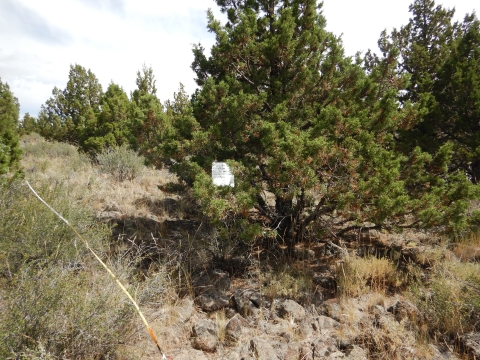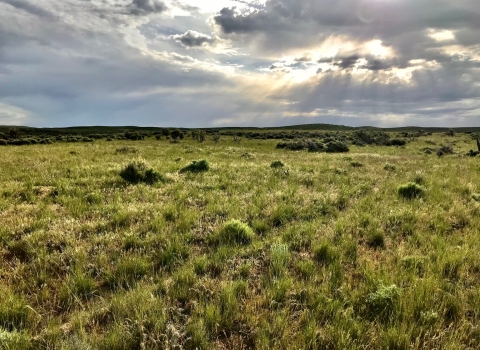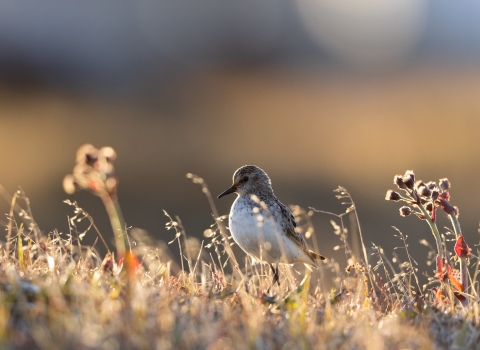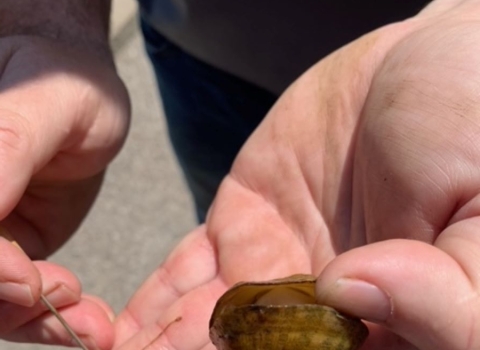As the sun rises in the purple, grey morning sky of the high mountain desert, the astringent smell of sagebrush sagebrush
The western United States’ sagebrush country encompasses over 175 million acres of public and private lands. The sagebrush landscape provides many benefits to our rural economies and communities, and it serves as crucial habitat for a diversity of wildlife, including the iconic greater sage-grouse and over 350 other species.
Learn more about sagebrush grows stronger. As the temperature warms, the morning dew gathered on each leaf is evaporating – tiny invisible puffs of water and oil perfuming the desert.
In the distance, dark smudges stain the low hills in wide bands, jarring against the sea of soft colors.
Those interloping shadows are cast by juniper trees. Though they are an important part of the Great Basin Desert ecosystem, their overabundance is pushing out other native plants and sagebrush, disrupting the delicate balance of the Great Basin Desert ecosystem, and negatively impacting the wildlife that depend on this habitat.
Too Much of a Good Thing
At Sheldon National Wildlife Refuge and Hart Mountain National Antelope Refuge conservation managers and partners are working together to push back the increasing population and presence of Western junipers. They have been expanding their range throughout the West, thanks largely to industrialized human manipulation of habitats, widespread suppression of wildland fire and changes in climate. Though an important part of Western landscapes, these historical and ongoing disturbances to the ecosystem are allowing junipers to grow in places they don’t belong. Studies have shown that when juniper numbers are reduced and the balance restored in sagebrush shrub, the amount and types of wildlife present increases.
As the great American West is getting smaller, places for wildlife and plants that are undisturbed are increasingly rare. Protecting and restoring important habitat ensures a future for wildlife and people to enjoy this uniquely American landscape. Protected places like national wildlife refuges are key for the future of the plants, wildlife and fish of the northern Great Basin. Wildlife that depend on the shrub steppe landscape protected by the refuges include large herds of antelope, bighorn sheep, elk, sage grouse, migrating waterfowl - even the elusive and adorable American pika.
Since the early 2000s, refuge managers at both Sheldon and Hart Mountain National Wildlife Refuges have been fighting back the encroaching junipers. Projects to date have primarily focused on priority areas for water resources and around sage-grouse leks and in areas known to be or to have been nesting, brood-rearing, late-season and/or over-wintering sage-grouse habitats.
Thanks to the Bipartisan Infrastructure Law Bipartisan Infrastructure Law
The Bipartisan Infrastructure Law (BIL) is a once-in-a-generation investment in the nation’s infrastructure and economic competitiveness. We were directly appropriated $455 million over five years in BIL funds for programs related to the President’s America the Beautiful initiative.
Learn more about Bipartisan Infrastructure Law , the effort to reduce Western juniper encroachment is receiving $617,000 to continue the fight. This investment will support critical sagebrush habitat management on the refuges by addressing the most serious factors: encroaching juniper, conserving and providing functioning springs, seeps and riparian riparian
Definition of riparian habitat or riparian areas.
Learn more about riparian areas and helping control invasive plants.
Cutting Back Western Junipers
Removing Western junipers is exacting and scientific work. Clearing juniper starts with a rapid assessment of the incursion, looking for areas that have the highest likelihood of being successfully restored once the juniper is removed. Biologists gather information and identify existing conditions – how much juniper is there? Where is it located? Habitat experts then develop a prescription for restoration, typically producing a map has a guide. The prescription and map identify where all, some or even no juniper should be removed in order to best help wildlife and restore balance to the habitat. The treatment plan includes methods for removing juniper, managing or burning the juniper piles that result from the removal, monitoring the site and identifying recovery actions.
For example, the prescription may require a lot of juniper to be removed in one area. In this case, the trees can’t just be left on the ground. The crew contracted to do the juniper cutting would next cut the trees into pieces and create a pile for prescription fire crews to later burn. The pile of ashes left behind will be reseeded with native seeds collected from nearby plants. Throughout this process, biologists and refuge managers are monitoring the project and making adjustments as needed. The process can take at least a year from habitat assessment to seeding.
Using this method and working with partners, the refuges have restored over 30,000 acres of juniper-encroached shrub-steppe habitat since 2014. Over the next year, the Bipartisan Infrastructure Law will allow the refuge to expand the project, targeting high value conservation areas, including pronghorn antelope migration corridors, mule deer fawning areas and mule deer and bighorn sheep foraging habitats.
Removing Western juniper will help managers rebalance the ecosystem - restore sagebrush step habitat and water resources and reduce fuel loading that contributes to wildfires.
Restoring Essential Water Resources
The Great Basin desert is functionally a large catchment, none of the waters drain to the sea. Instead, they flow into valleys and remain in the desert in springs and wetlands or recharge groundwater. Water features are uncommon in the Great Basin, making the impact of each one on wildlife populations and plant life that much more important. They often support rare or unique endemic species (many currently undescribed to science) and are irreplaceable sources of water and food production for most species of desert wildlife.
At Sheldon, most of the water resources have been impacted by feral livestock grazing – fundamentally altered to feed troughs or spring boxes or by the impact of hooves and large bodies. The encroachment of Western junipers in water drainages and systems has compounded and magnified the existing damage to these precious resources. Junipers are comparatively water intensive plants, meaning they require a lot of moisture and groundwater to survive compared other desert plants. When there are too many of them in a drainage, wetland or wet meadow they can throw off the hydrological balance – robbing important riparian plants such as shurbs, forbs and grasses of the moisture they need to survive. Additionally, when junipers are present in thick patches, they create a canopy cover that prevents those plants from growing.
The Bipartisan Infrastructure Law will fund a project to restore approximately 17 springs and associated springbrooks and meadows in areas of the refuge that have had juniper removal efforts already completed. Starting in the fall of 2022, hydrological experts and refuge mangers will begin the field work and assessments. It’s the first step of the project to reclaim vital water resources for wildlife and plants.
Building Back Better
Rebalancing the ecosystem at Sheldon and Hart Mountain refuges is building increased habitat, water and wildfire resilience, ensuring that generations of future Americans will enjoy the beauty and benefits of the Great Basin ecosystem. Whether hunting pronghorn, hiking canyon rim trails or watching sage-grouse as they thrum their chests and dance across their leks, we can all benefit from more water, more wildlife and less wildfire on our public lands.






